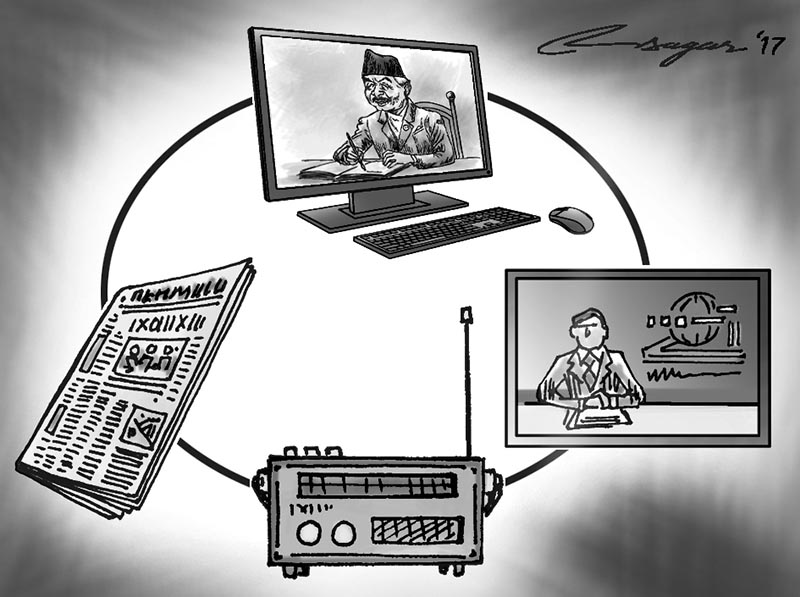Nepal media role: Matter for debate
We have learnt that in the context of media power and media markets, the nature and importance of media institutions and media policy cannot be undermined
Evidently the media world in Nepal has undergone massive change. The monopoly of state-owned media is gone; stiff media market condition prevails. Institutional and organizational forms have started to produce and distribute diverse and unprecedented variety of media content. And the readers, listeners and watchers have become more literate more curious to be informed and know about the happenings in and around the world.
Advanced technological means of communication and infrastructure are available to speed up the process of human communication in the Nepali context. Now Nepalis are getting used to the two-way communication as they are increasingly accessing the Internet for interactive social media. There is however a variation in data of the Internet use in Nepal; I guess on average 66% of the total Nepali population now can access the network. It has become a matter of grave concern for thinking Nepalis how the power of media, particularly social media, will determine how a Nepali life may be lived in and abroad in diaspora.
The Nepalis are beginning to understand that media are not just a part of larger social institution only but they can also be privately owned commercial business media. In fact, they have to come to invest in media industry expecting a return of huge profits. Naturally the advertising business is also flourishing, and it is asserting its rights over national media against foreign advertising time purchase.
However, with the increasing global mediation of culture, reception of informational symbolic culture has begun in contexts without distinction of public and private concerns. The question is can we mitigate the effects of seemingly border less ICTs? Symbolic power unlike coercive, political or economic powers, matters because it is this power through which values, beliefs and ideas can subtly be transformed. We have learnt that media organizations operate in the market for creative content, besides the market for financial resources and for audience and users.
Meanwhile, we have also learnt that in the context of media power and media markets, the nature and importance of media institutions and media policy cannot be undermined. Especially, in developing countries, which more or less have a history of colonial rule, the struggle for freedom of expression or press against the institutionalized governance mechanism has been titanic. Nepal’s story is bit different. The Nepali press did not struggle through the repressive colonial rule as imposed on the Indian press before British India gained independence in 1947.
In fact, the first publication of the newspaper in Nepal was in Nepali and it was first initiated by the autocratic ruler himself in the first year of the 20th century, unlike in British India where towards the last quarter of nineteenth century a retired employee of the East India Company had first started a four sheet newspaper in English. In Nepal, the English language journalism appeared only after the overthrow of the Rana regime, but in India until its independence in 1947, native Indians or Anglo-Indians could hardly displace Englishmen from ownership or editorial control of the press except in rare cases like that of Raja Ram Mohan Roy, Balgangadhar Tilak or even Mahatma Gandhi.
Given the political environment in which the Indian press and the Nepali press developed the nature of their struggle for freedom of press also differed. However both the countries are now free of the authoritarian rule, though Nepal was late in achieving the federal republican status. But by all indications Nepal may get rid of poverty earlier than India.
The debate is going on what role Nepali media may play in the process of socio-economic development process. Can it be conceived as leading to the end product of strategic state-led interventions with active support of the media or as the result of market forces left to themselves along with the socially responsible media?
During the second half of the 20th century, massive scholarly efforts to discover the truth and to prescribe solutions to the problems of socio-economic development have been made, particularly at the UN auspices. And for training journalists in the area of developing communication the contribution of Indian Institute of Mass Communication cannot be minimized.
Myself being a university teacher of development communication I can hardly ignore the practical implications of the development communication for Nepali society and its development in the context of media globalization and governance.
Sometimes in my academic effort to understand the performance of the mainstream print media, I choose to assign the Master’s level students to undertake a survey project to gather , analyse and interpret the development message and contents.
My point is there is a generation of young Nepalis studying at higher academic level who needs to be groomed to undertake the scholarly pursuits of media research, and discover the truth of relevance or not of development communication plan and strategy for Nepal that is aspiring to join the group of countries who have already attained the middle level of development status?






